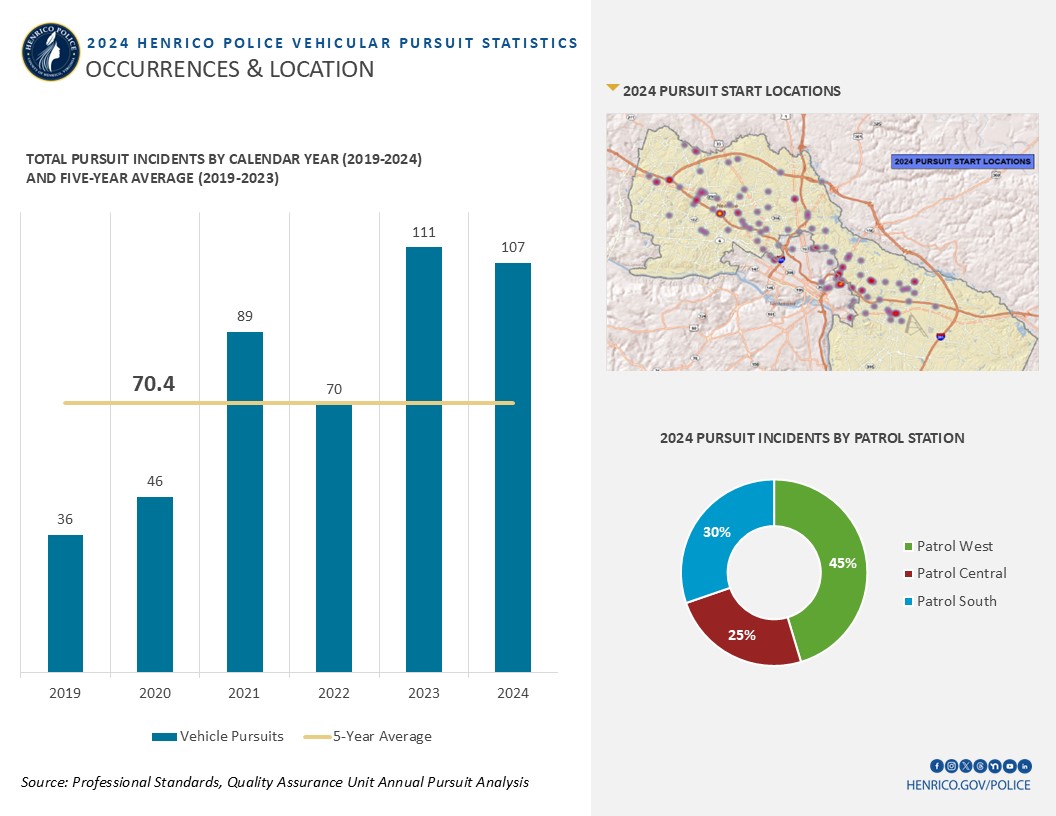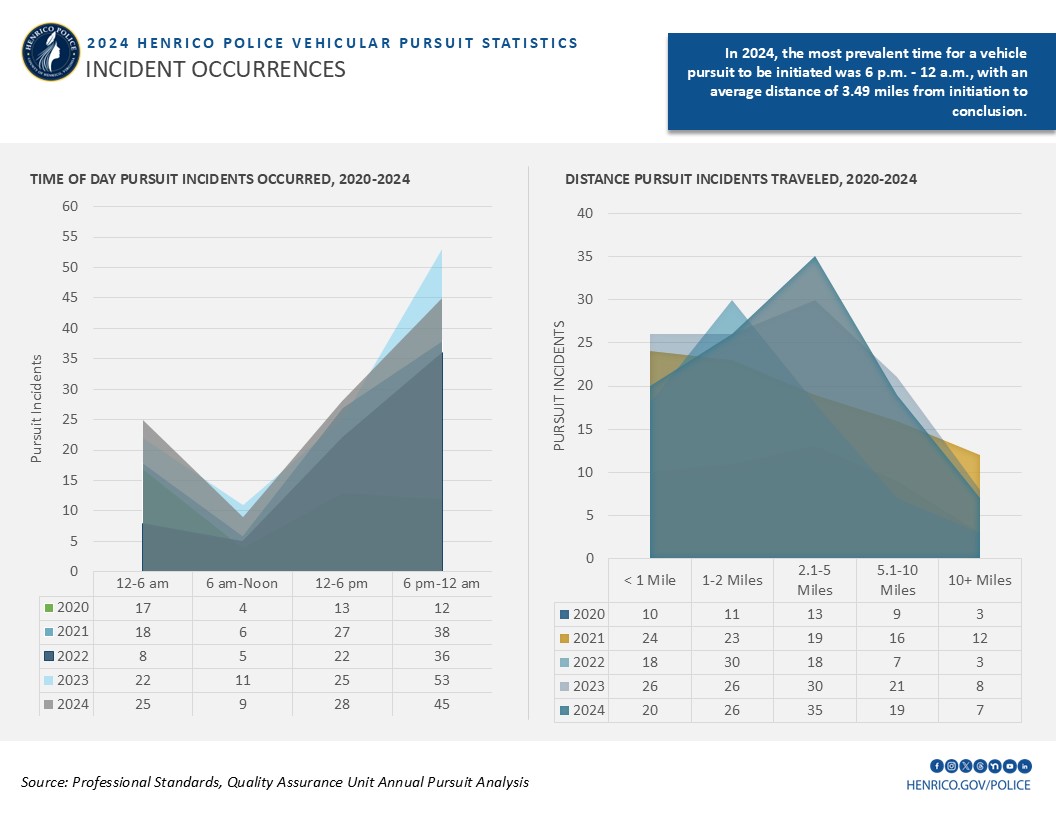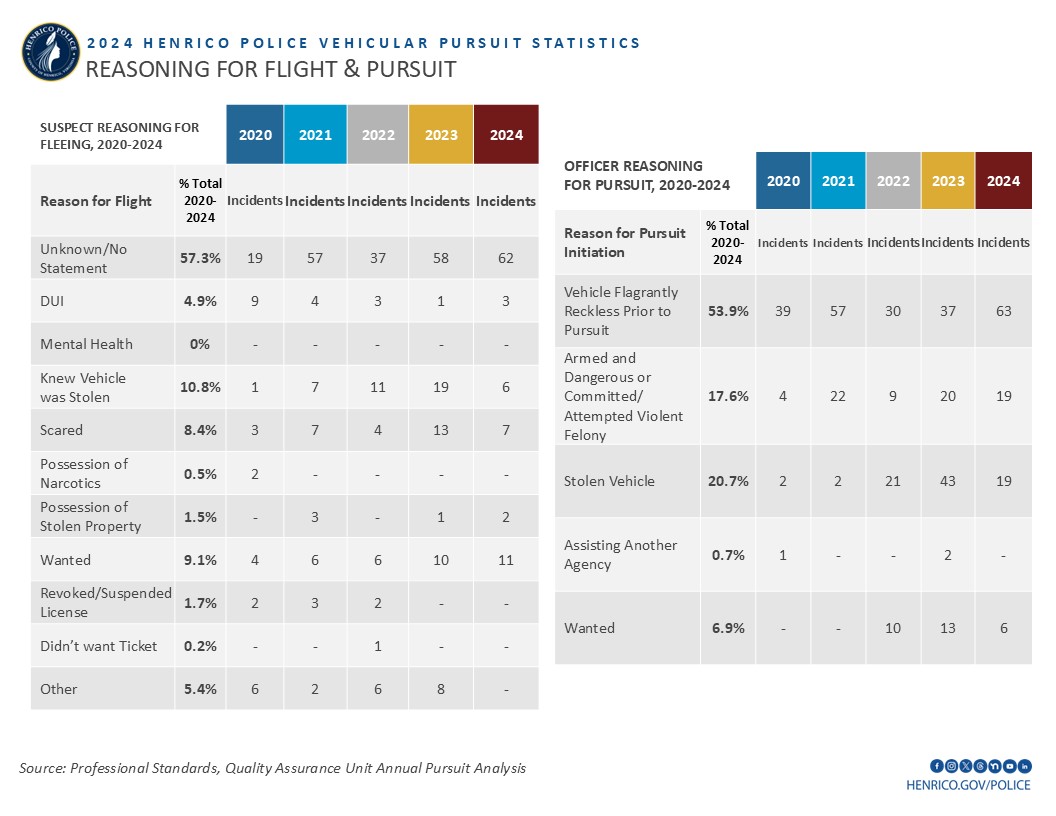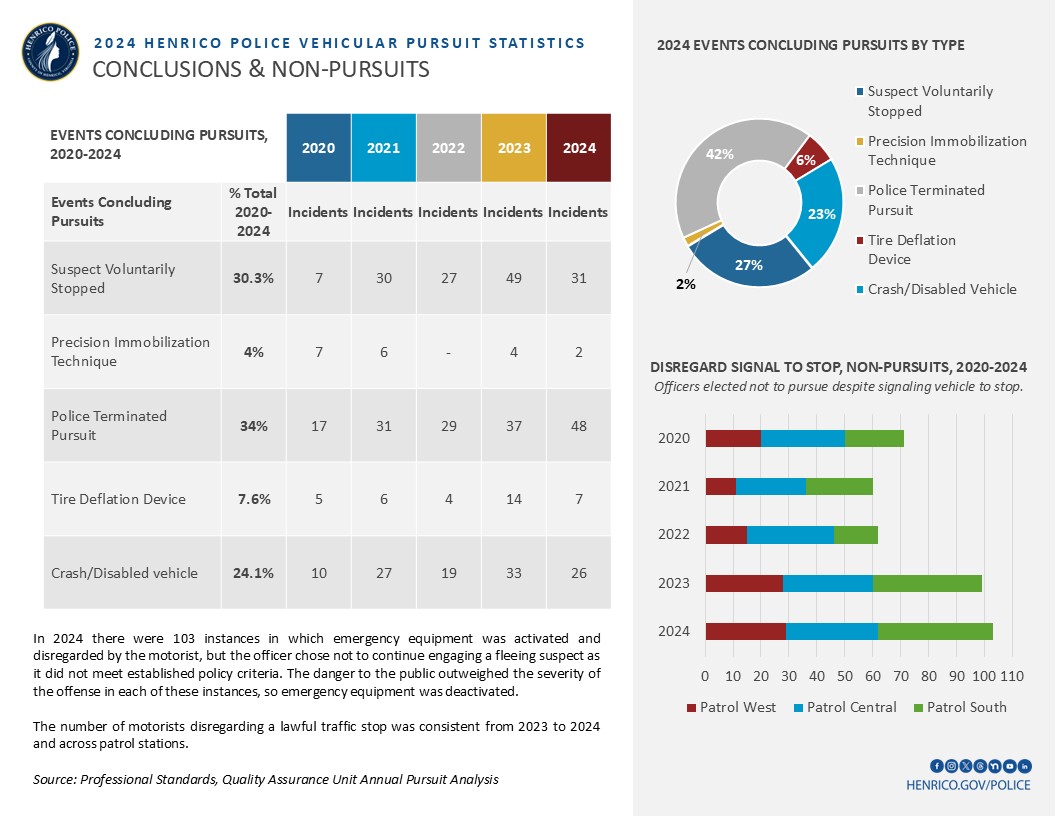
POLICE TRANSPARENCY:
2024 VEHICULAR PURSUIT REPORT
Since vehicular pursuits create the potential in which officers, members of the public, and/or the suspect may be killed or seriously injured, pursuits shall only be initiated and continued in accordance with the provisions set forth by Division policy.
The decision to initiate a pursuit is a difficult one. The decision to terminate a pursuit is even more difficult. Professional judgment and common sense are the determining factors.
2024 Statistics
Pursuits decreased slightly (3.6%) from 2023 to 2024. The previous five-year average was 70.4 pursuits; 2024 was a 52% increase over the five-year average.
Officers’ reasons for initiating a pursuit were similar from 2023 to 2024 with one exception – pursuing a stolen vehicle dropped from 37.7% in 2023 to 17.76% in 2024.
Analysis of the age of the pursued reveals an average age of 28, down by roughly 2 years from the previous four-year period. Analysis of 2024 pursuit data revealed the youngest age, and the average age of a pursued individuals were all younger than the previous year. The Police Division continues to seek enhanced pursuit training opportunities for sworn personnel and continuously evaluates pursuit data for policy revision considerations and officer development. These measures in conjunction with proper equipment allocation, policy transparency, and community feedback enhance community safety during pursuit events.
[DOWNLOAD: 2024 Vehicular Pursuit Data]
Incident Occurrences & Location


Reasoning

Pursuit Conclusions & Non-Pursuits

POLICY
The authority of a law enforcement officer to engage in vehicular pursuits stems from the duty to apprehend law violators. When officers engage in vehicular pursuits utilizing emergency lights and siren, they shall do so in accordance with existing statutes and this directive. Since vehicle pursuits create the potential in which officers, citizens, and/or the suspect may be killed or seriously injured, pursuits shall only be initiated and continued in accordance with the provisions set forth herein.
The decision to initiate a pursuit is a difficult one. The decision to terminate a pursuit is even more difficult. Professional judgment and objective reasonableness are the determining factors. It shall be noted that a police officer and police supervisor can be held civilly liable for damages and injuries that occur during a pursuit. The pursuit policy for vessels is the same as vehicles.
DEFINITIONS
- Active School Zone: School zone that is controlled by signs with flashing yellow lights indicating a reduction in speed or in residential areas where school zones are denoted by road signage and the school is actively accepting or dismissing students.
- Armed and Dangerous: A person who has committed or attempted to commit any offense involving the unlawful discharge, display, possession, or use of a weapon or explosive device in such a manner as to provide an officer reason to believe that the person presents an immediate threat to the public.
- Reckless Driving: Irrespective of the maximum speeds permitted by law, any person who drives a vehicle on any highway recklessly or at a speed or in a manner so as to endanger the life, limb, or property of any person (Code of Virginia § 46.2-852).
- Terminate: To discontinue or stop pursuing a vehicle.
- Tracking Devices: Electronic devices able to transmit the vehicle’s location in real-time. The device may be a permanent vehicle component, a temporary vehicle component, or an electronic device within the vehicle.
- Vehicular Pursuit: An active attempt by a law enforcement officer operating an emergency vehicle while displaying flashing, blinking, or alternating emergency lights, and sounding an intermittent siren to apprehend a suspect who is actively attempting to elude apprehension while operating a moving vehicle.
- Violent Felony: Any felony involving the use or threatened use of physical force or violence against another person including, but not limited to, murder, manslaughter, mob-related offenses, rape, kidnapping or abduction, robbery, malicious wounding, escape by force, placing or detonating a destructive/explosive device or bomb.
Forcible Stopping Techniques
- Intentional Contact – The act of deliberately making contact with a suspect’s vehicle for the purpose of containing the suspect’s vehicle. Intentional contact may be used as part of a pre-planned vehicle containment or dynamic vehicle containment. Intentional contact is a trained containment technique to be performed only on slow moving or stationary vehicles. For additional information on Intentional Contact see LP-08B Vehicle Containment.
- Precision Immobilization Technique (PIT): The intentional act of utilizing a Police Division vehicle in a prescribed manner to physically contact a fleeing vehicle in order to force it from its original course of travel to a stopped position.
- Ramming – The intentional act of using a Police Division vehicle to deliberately contact another vehicle with the intent of preventing or impeding the other vehicle from moving or fleeing. PIT and Intentional Contact are not included in ramming.
- Roadblocks: Means the establishment of a barrier across all or a part of the traveled portion of a roadway. This barrier may be moving (as in the case of vehicles placed in front of a fleeing vehicle), or stationary. Roadblocks are frequently established using police vehicles as a barrier but may utilize other objects.
- Tire Deflation Device: A device designed to stretch across the roadway with hollow spikes designed to puncture tires of vehicles that run over them, slowly deflating air from the tire slowing the vehicle and ultimately bringing it to a stop.


